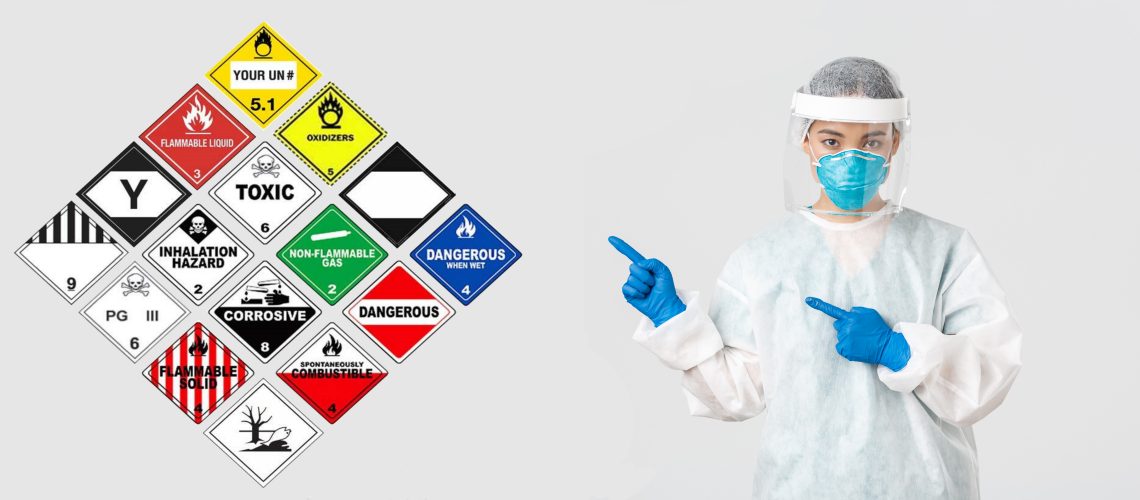Chemicals are present in almost every industry and play an essential role in manufacturing. However, the improper handling of chemicals can have serious consequences, including injuries, illnesses, and even fatalities. It is critical for employers to implement adequate safety measures to protect workers from chemical hazards in the workplace. This article will discuss best practices and regulations for chemical safety in the workplace.
Chemical Hazards
Chemical hazards are classified into four categories: physical, chemical, biological, and ergonomic. Physical hazards include fire, explosions, and radiation, while chemical hazards refer to the potential for exposure to harmful substances. Biological hazards include exposure to microorganisms, while ergonomic hazards result from improper posture, lifting, and repetitive motion.
Identification of Chemical Hazards
The first step in chemical safety is identifying the hazards in the workplace. Employers must maintain an up-to-date list of all hazardous chemicals used in the workplace, including their properties, handling procedures, and potential hazards. The Material Safety Data Sheet (MSDS) provides detailed information about the hazards of a particular chemical and must be readily accessible to workers.
MSDSs contain a wealth of information, including the chemical name, product identifier, supplier information, physical and chemical properties, health hazards, first-aid measures, fire and explosion hazards, handling and storage precautions, exposure controls, and personal protective equipment (PPE), and emergency procedures.
By providing this information, MSDSs help employers identify and evaluate the hazards associated with chemicals used in the workplace. Workers can use MSDSs to understand the risks associated with handling and using a particular chemical and take necessary precautions to minimize exposure.
MSDSs are also important to comply with regulations such as the Hazard Communication Standard (HCS) developed by the Occupational Safety and Health Administration (OSHA) in the United States. The HCS requires employers to establish and maintain a hazard communication program, including the provision of MSDSs for all hazardous chemicals used in the workplace.
Risk Assessment
Once the hazards are identified, a risk assessment must be performed to determine the potential harm to workers and the measures necessary to control exposure. The assessment should consider the nature and amount of the chemical, the duration and frequency of exposure, and the routes of exposure (e.g., inhalation, skin contact, ingestion).
To perform a risk assessment, employers must first identify all chemicals used in the workplace and their potential hazards. This can be done by reviewing the Material Safety Data Sheets (MSDSs) for each chemical and any other relevant information, such as scientific literature and regulatory guidelines.
Next, employers must evaluate the level of risk associated with each chemical. This involves considering the nature and amount of the chemical, the duration and frequency of exposure, and the routes of exposure (e.g., inhalation, skin contact, ingestion). For example, a highly toxic chemical used frequently and in large quantities poses a greater risk than a less toxic chemical used infrequently and in small quantities.
Hierarchy of Controls
The hierarchy of controls is a framework used to prioritize control measures based on their effectiveness in reducing exposure to chemical hazards. The hierarchy includes the following:
- Elimination or substitution: Involves removing the hazard or replacing it with a less hazardous alternative.
- Engineering controls: Includes include physical barriers, ventilation systems, and other measures to minimize exposure.
- Administrative controls: Consists of policies and procedures that reduce exposure, such as training, work practices, and scheduling.
- Personal protective equipment (PPE): PPE, such as respirators, gloves, and protective clothing, is the least effective control measure and should only be used when other measures are not feasible.
Chemical Storage
Proper chemical storage is essential for preventing accidents and minimizing exposure. Chemicals must be stored in a manner that minimizes the risk of exposure to workers and reduces the likelihood of accidents or spills.
The first step in proper chemical storage is to identify all hazardous chemicals used in the workplace and ensure that they are properly labeled. Each chemical should be labeled with its name, hazard warnings, and the name and contact information of the manufacturer or supplier. Labels should be clear and easy to read and should be updated if there are any changes to the contents of the container.
Once chemicals have been properly labeled, they should be stored in a secure location. This location should be well-ventilated and away from incompatible substances, such as acids and bases. Flammable liquids should be stored in a flammable liquids cabinet, and chemicals that require refrigeration should be stored in a designated refrigerator. Chemicals should be stored in their original containers or in containers that are specifically designed for chemical storage.
Chemicals should be organized and stored in a way that minimizes the risk of accidental spills or leaks. Chemicals should be arranged in a way that makes them easy to access, and containers should be stored on shelves or in cabinets that are designed to hold them securely. Containers should not be stored on the floor, and heavy containers should not be stored on higher shelves.
In addition to proper storage, it is important to have a system in place for monitoring chemical storage areas. Chemical storage areas should be regularly inspected for signs of leaks or spills, and any damaged or leaking containers should be immediately removed and disposed of in accordance with applicable regulations.
Finally, workers should be trained on proper chemical storage procedures. This training should include information on the hazards of different chemicals, the proper handling and storage of chemicals, and emergency procedures in case of a spill or release.
Training and Education
Training and education are essential components of chemical safety in the workplace. Workers must be trained and educated on the hazards of chemicals in the workplace and the measures necessary to prevent exposure. This helps to ensure that workers are aware of the risks associated with their work and can take appropriate measures to protect themselves and others.
Training should cover a range of topics related to chemical safety, including the proper handling, storage, and disposal of chemicals, as well as emergency response procedures in case of a spill or release. Workers should be trained on how to use personal protective equipment (PPE) such as respirators, gloves, and protective clothing and when to use it. Training should also cover the proper use of engineering controls, such as ventilation systems and physical barriers, to minimize exposure to hazardous chemicals.
It is important that training is provided in a language and format that workers can understand. Employers should take into account workers’ literacy levels and cultural backgrounds and provide training materials in multiple languages if necessary. Training should also be tailored to the specific needs of different job roles and levels of responsibility.
Employers should ensure that all workers receive initial training on chemical safety when they are hired and provide ongoing training and refresher courses as needed. This is particularly important when new chemicals are introduced into the workplace or when changes in work processes may impact workers’ exposure to chemicals.
In addition to training, education is also important in promoting chemical safety in the workplace. Employers should provide workers with access to information about the hazards of chemicals, such as Material Safety Data Sheets (MSDSs), and encourage them to ask questions and report any safety concerns. Employers should also provide information on the rights of workers to a safe and healthy workplace and encourage workers to speak up if they feel that their safety is being compromised.
Regulations
Regulations play a critical role in promoting chemical safety in the workplace. There are several regulatory agencies and laws that govern chemical safety, including the Occupational Safety and Health Administration (OSHA), the Environmental Protection Agency (EPA), and the Toxic Substances Control Act (TSCA).
The OSHA Hazard Communication Standard (HCS) is one of the most important regulations related to chemical safety. The HCS requires employers to develop and maintain a hazard communication program, including labeling hazardous chemicals and providing Material Safety Data Sheets (MSDSs) for all hazardous chemicals used in the workplace. The HCS also requires that workers receive training on the hazards of chemicals in the workplace and the measures necessary to prevent exposure.
OSHA also regulates exposure limits for many chemicals, such as benzene and lead. These exposure limits are known as Permissible Exposure Limits (PELs) and are designed to protect workers from the harmful effects of exposure to chemicals. Employers are required to monitor worker exposure to hazardous chemicals and take action if exposure levels exceed the PELs.
The EPA also plays an important role in chemical safety in the workplace. The agency regulates the handling and disposal of hazardous waste, including chemicals. The Resource Conservation and Recovery Act (RCRA) requires facilities to manage hazardous waste in an environmentally sound manner and to properly label and store hazardous waste.
The TSCA is another important regulation related to chemical safety. The TSCA requires manufacturers to report on the production and use of chemicals and provides the EPA with authority to regulate chemicals that pose an unreasonable risk to human health or the environment. The TSCA also requires that manufacturers provide information on the hazards of chemicals and how to safely handle and use them.
In addition to these federal regulations, there may be state or local regulations that govern chemical safety in the workplace. For example, some states have their own OSHA-approved occupational safety and health programs that include additional requirements for chemical safety.
Partner With Noah Chemicals for a Safe and Secure Chemical Environment
At Noah Chemicals, we take pride in our commitment to chemical safety in the workplace. Our high-quality chemicals are manufactured to meet strict safety and compliance standards, and we use state-of-the-art equipment and rigorous testing procedures to ensure their safety and effectiveness.
We also offer a range of services to help our customers maintain chemical safety in their workplaces. Our consultations provide valuable information on the proper handling and storage of chemicals.
At Noah Chemicals, we believe that safety is paramount, and we strive to provide our customers with the highest level of safety and security in their use of chemicals. We are committed to maintaining our high standards for quality and safety. We are proud to be a valuable partner for any business that prioritizes the safety of its workers and the environment. Contact us today to schedule a consultation or call us at (888) 291-1186.




